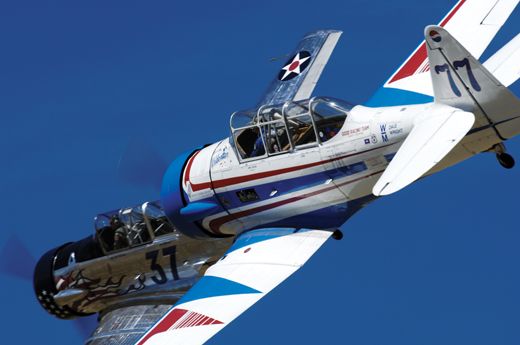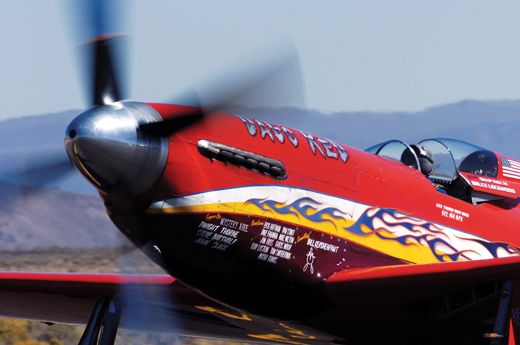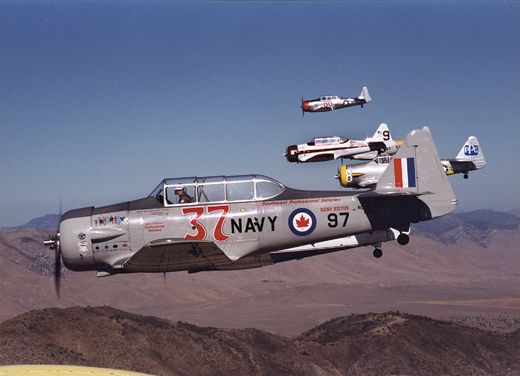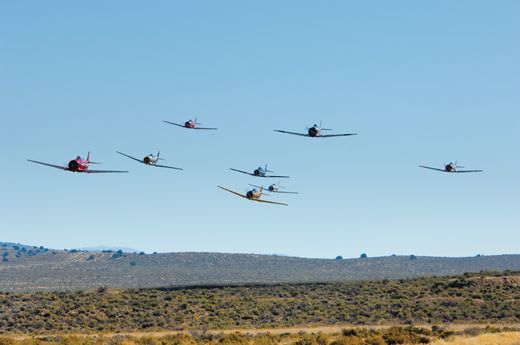The Physics of Winning
What Reno air race winners know that losers don’t.
/https://tf-cmsv2-smithsonianmag-media.s3.amazonaws.com/filer/reno_631-jan07.jpg)
To me, the most enjoyable kind of racing involves laps around a circuit. Whether it’s at the Reno air races in Nevada or NASCAR’s Richmond International Raceway in Virginia, all the competitors are within view throughout the entire event. Races on road courses that take the field out of sight for minutes at a time aren’t as much fun; same goes for cross-country air races. Drag races are over before they begin. Whether the racers are in cars or airplanes, being able to see the lead changes and race tactics makes the experience more exciting. Ask NASCAR, which has discovered the master key to motor racing popularity in oval-track racing, some on courses as short as Tennessee’s Bristol half-mile circuit, where a straightaway may take only a couple of seconds. NASCAR fans live for the action in the turns.
On the straights, the dominant factor is a racer’s horsepower, but the moments that bring racing fans to their feet tend to occur when close competitors are battling through turns. It’s as true for air racing as it is for stock cars: Some racers, perhaps gifted or simply well trained, make each lap seem effortless. And these are the competitors who seem to win most often. Is there something at work here—some law of physics, perhaps—that rewards smoothness in executing a turn? And despite the marked differences in the machines, are there elements common to successful turning in both road racing and air racing?
I asked experts in both fields to examine the factors that make for a fast lap on the ground and in the air. It was unanimous: The most important element to racing is the line—the path that defines the fastest way around any turn, the curving path that connects the entrance to a turn and the exit from it. In oval-track racing as well as at Reno, there are at least two turns on the circuit, each producing a reversal of direction. This is where races are won and lost.
Yet two perfectly matched race cars can, in the hands of different drivers, deliver different results. What makes a winner? Stephan Wilkinson is the author of The Gold-Plated Porsche, a memoir about restoring a 911SC that he drives at race tracks for the sheer pleasure of going fast legally. (He’s also a pilot and contributor to Air & Space/Smithsonian.) “Smoothness counts for a lot in a car,” he says. “And I wonder if there’s a parallel there with air racing. I always instruct people to imagine that their car is like a big beach ball, and that it tips or pitches in response to braking, accelerating, turning. You can’t do these things ‘gently’ at racing speed, but you can do them smoothly. You can always tell the inexperienced drivers, whether it’s in movies or on the track: They jump on the brakes, jump on the gas, saw the wheel…all that too-fast-too-furious stuff is the antithesis of what a competitive driver does.”
Race car teams spend a lot of time adjusting tire pressures and suspension springs to find the sweet spot where the driver feels comfortable in turns. The mechanics try to balance understeer, or “pushing” in NASCAR lingo, and oversteer, a condition NASCAR folks call “loose.” With understeer, a car wants to head toward the wall rather than follow the front wheels around a turn; with a lot of oversteer, the rear end of the car wants to head to the wall—come loose—and thereby point the nose of the car deeper into the turn. In essence, the car turns more than the front wheels want it to: It oversteers. In either condition, turns will cause the car to lose speed.
Though air racers don’t have the colorful lingo of the good ol’ boys on the Nextel Trophy circuit, they do much the same thing with their airplanes. Most try to relax the airplane’s static pitch stability by moving the center of gravity as far aft as possible without making the airplane unsafe in slow flight. This reduces the work the horizontal tail has to do to keep the airplane balanced in turns (see “Balancing the See-Saw,” below), and reducing the workload of the tail reduces drag.
Mary Dilda took the North American T-6 Gold race at Reno in 1997 and 2005 and the Jet Class Gold in 2003. To dissect the technique that makes her flying appear so languid, she narrates a hypothetical three-pylon turn: “First, create the least amount of drag,” she says. “The ailerons create drag when you enter a turn, so ideally you plan the turn…and begin the roll early, very slowly, barely putting aileron in, a little rudder to keep the nose down as you roll in. You start early enough and hold your bank all the way around the pylons and slowly roll out after the third pylon. So you never think about the second pylon and just create as little drag as possible with the ailerons.”
Assistant and husband Steve adds, “We watched a lot of race car drivers. When they enter a turn, they try to [steer along a path] so they generate the least amount of wheel movement, and that’s less drag they’re creating on the car. That’s exactly what we try to do, so their steering wheel and our control stick are identical.
“Anytime we pull back on the stick, the elevator deflection increases drag. Anytime you can make a turn with the least amount of control deflection—the least amount of drag—that’s your goal.
“It’s a matter of both talent and mastery. Some people are very mechanical and have to think about [flying smoothly and minimizing drag]. Others don’t concentrate as hard but still have to think about it.” Steve Dilda thinks you can see the differences in technique during a race: “I’ve seen it on videos: airplanes that look like they’re flying on a rail. Others you see skidding around turns, nose up and not going anywhere.”
Todd Serota is a California lawyer, novice pilot, and Massachusetts Institute of Technology grad who put together events that placed fellow MIT grads in race cars for a day. Eventually it grew into a business, Tracquest, which he recently sold. He estimates that he has instructed drivers at some 200 events. “In my driver meetings, I stagger the sessions for advanced, intermediate, and beginning drivers,” he says. “When I address the novices, I remind them of the old saying about real estate [location, location, location]. I semi-jokingly tell them that driving is the same: It’s smoothness, smoothness, smoothness.” But he says that the repetition of “location” actually emphasizes that in real estate, there’s only one factor, whereas the equivalent phrase in racing refers to three distinct factors. “They are [steering] wheel, brake, and throttle,” he says. “So [in racing], smoothness has a triple meaning.”
The popular perception may be that he who hugs the ground and the pylons wins, but that’s not how leading racers describe the best line. “It’s the fastest way, not the shortest,” says Lyle Shelton, veteran racer and owner of the Grumman Bearcat Rare Bear. “I had an engineer plot it out. He plotted a constant-G line, the fastest way around the course. I’d figured it out myself by the seat of my pants by that time.” Shelton says he doesn’t like to exceed 4 Gs around any turn. “You get it built into your britches. I like about 3.5 G, never more than 4.”
He uses different words—the “softer” turn is faster—another way of stating what the Dildas observed. “It didn’t take me long after I started racing in 1965 in a P-51 to learn that softer turns made faster speed.” He no longer flies the Bear himself, but Reno race fans still talk about Shelton’s fluid line. “Instead of running up on a pylon and honking it around the pylon, the most constant bank you can use works better,” he says.
If a car is at a speed that puts it at the limits of tire adhesion as it enters the turn, centrifugal force will carry the car off the track—it spins out. The simple act of steering forces the tires to work harder in a lateral direction, adding friction and scrubbing off speed. One difference between cars and airplanes is that pilots race with the throttle at its forward stop, whereas car racers back off the gas when entering a turn, then floor it when they accelerate out of the turn.
When a pilot pulls a 70- to 80-degree bank in turns, the Gs scrub off speed the way the friction of the front tires does on cars. To pull those Gs, pilots are pulling the stick back, pitching the nose up toward the inside of the turn and increasing the angle of attack of the wings to increase their lift and counter the centrifugal force that can make a 200-pound pilot
feel as though he weighs 800 pounds.
In the 1990s, Bill “Tiger” Destefani flew the modified P-51 Strega to victory against competitors with more horsepower. He explains his advantage in terms of pulling Gs: “You’ve got to get through the turn with the least amount of Gs. Gs equal drag. We’ll put enough weight in the tail so if you’re pulling up to 4 Gs in a turn, the tail-heavy airplane goes faster.” Flying Strega was all finesse, he says. “No rudder in the straights. In the turns, just a liiii-tle bit.” His team went to great efforts to remove every last bit of trim pressure that would be exerted at top speed. Even a small surface like a trim tab or a tiny control deflection adds drag.
Steve Potter, vice president and general manager at Lime Rock Park, a race track in Connecticut, says his first experience in a race car was very different from how he’d imagined it, and he’s spent years thinking about the challenge of driving at speed—and about the line.
“In the entire span of nature’s time, until an eye-blink ago, humans lived in a 20-mile-per-hour world. All of our sensory systems have evolved to live with that. The trick is to slow the world, when you’re in a vehicle, down to 20 mph. Look out a side window, and at 50 mph, the guardrail is a blur. If you look far enough down the road, things are not approaching very quickly. To follow the line around a race track, it’s critical to learn to look far ahead and ignore what’s close.”
All well and good when you have a track to yourself at the Indianapolis 500 time trials or you’re just running practice laps at Reno. In real-world racing, you can find yourself in traffic or in somebody’s prop wash. And you can’t expect to enter every turn at precisely the right point. Racers learn to compensate when they can’t follow the ideal line or when they make a mistake and have to correct for it. On the track, drivers are trained to make optimum use of the tires’ grip by using part of their adhesion for braking, part for cornering, and part for acceleration out of the turn—all influenced mightily by the line through the corner.
A driver has the right to defend against being passed, and swinging wide in a turn is one way to block. That happened to Mary Dilda when she was trying to pass a competitor in 2005’s T-6 Gold race: “When he would roll into a turn, he was delaying the roll and hoping I was [flying as if in formation]. I flew my own line a little higher.” Although that gain in altitude might have forced her to expend energy, she says, “I didn’t have the G forces that he had to pull. He had to pull harder through the turn.” She got her spent energy back coming downhill after she passed the competitor’s T-6 handily.
“Sometimes in traffic, you get away from the optimum [line],” says Shelton. “You go outside somebody because of traffic or prop wash. Prop wash can whip you past vertical [90-degree bank] and really gets your attention. The wing can get stuck in the vortex and it won’t come out. Then it whips out, and it’s really a violent thing. Then you’ve got to settle back in.”
Though altitude gain and prop wash are alien to race car drivers, air racers and auto racers still have a lot in common. Shelton sums it up: “I’ve gone to the Motorsports Hall of Fame and talked to the auto, motorcycle, boat guys, and others, and we all talk the same language.”



